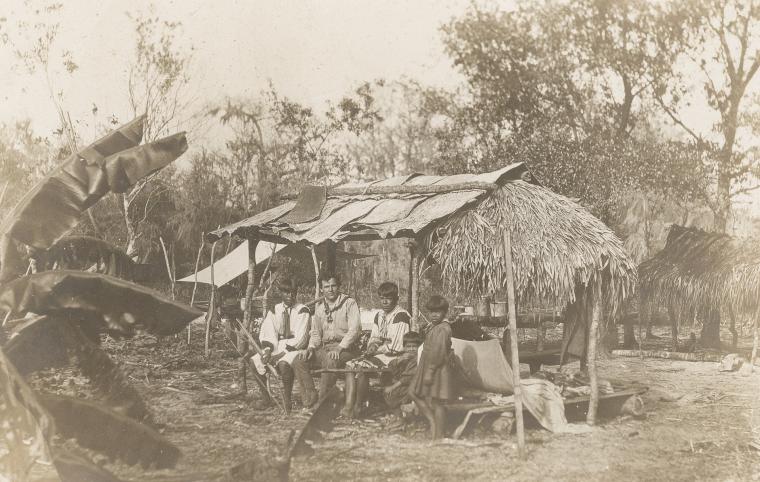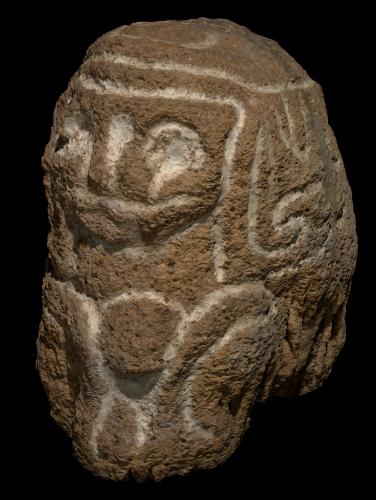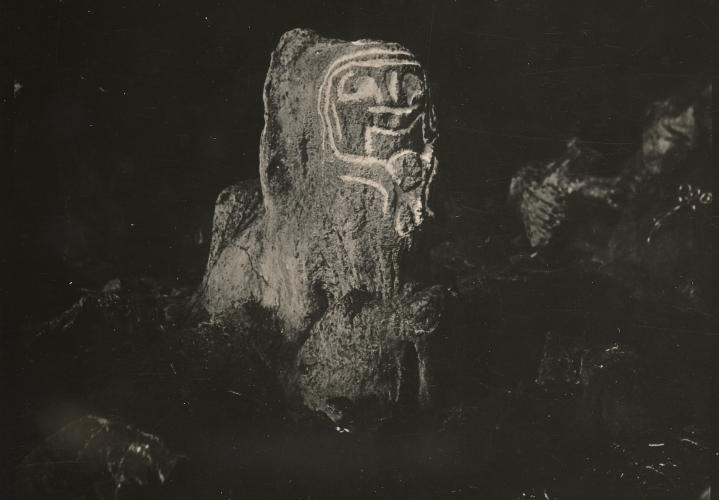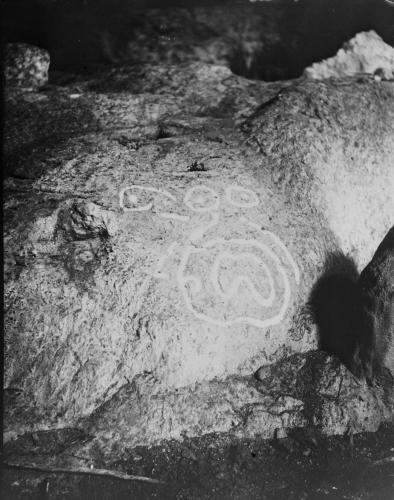A carved stalagmite from eastern Cuba sits in the collection of the Smithsonian National Museum of the American Indian. Known to archaeologists for a century as the “Idol of Patana,” it is a significant piece in the cosmology, or the understanding of the universe, of the Caribbean’s Taíno people. It is also a focus of international tension.
Archeologist Mark Harrington spotted the iconic idol in 1915 while excavating a remote cave on the easternmost coast of Cuba. As a researcher and buyer for George Gustav Heye—whose collection of American antiquities in New York formed the nucleus of the National Museum of the American Indian—Harrington explored many archaeological sites of Cuban Indians who belong to the Taíno culture. This culture (which some archaeologists prefer to call the “agro-potter” culture) encompasses the original grouping of Indigenous inhabitants of the Greater Antilles and the Bahamas.
The cave where the so-called Idol of Patana was found is located in the village of Patana, near the Point of Maisi. Academics have called it the Cave of Patana after the village, but it is better known locally as the “Cueva del Agua” (Cave of the Water), “Cueva del Cemi” (the Diety’s Cave) or sometimes as “Cueva del Bicho” (Cave of the Gremlin or Vermin).
In his 1921 monograph for the Museum in New York entitled “Cuba Before Columbus,” Harrington describes how he spotted the carving on the stalagmite in the cave by sheer luck. Benito Mosquera and his brother, local Cuban Indian descendants of the remote eastern coastline, guided the explorer to the large ceremonial cave. As Harrington entered, a snake revealed itself, perching atop the stalagmite. A Cuban colleague, he writes, “succeeded in capturing” the snake. Minutes later, the archaeologist spotted the carving. Harrington recollects that he “was astonished to find that a large stalagmite we had passed many times . . . had not only a plainly marked face, but indications of a body carved upon it.” The large carving “faced east, and was so placed by nature that at a certain time in the morning, at least during our stay in June and July, a shaft of sunlight striking through a crevice fell full upon the face of the figure for a few minutes.”
The idol had sat here, facing the ocean, for at least 500 years. Harrington left it in place, as it was heavy and strongly rooted. That evening, he filed a report about it to Heye in New York. The master collector of American Indian antiquities did not hesitate: “Get the idol,” he wired back.
Harrington writes that Mosquera provided the long, two-man saw used to serrate the stalagmite stone into heavy pieces. The sections were wrapped and strapped to a mule for the descent to the coast. Although the workers had “to oil and sharpen often,” the saw did the job on the front of the long, carved stalagmite, leaving behind the rest of the formation. Harrington serrated the front face of the “cemi” (the divine figure), then cut the base into five parts for shipping from the port of Baracoa to New York City.
Over time, Harrington extracted and shipped 36 large crates of artifacts from Baracoa in eastern Cuba to Heye’s museum. Alejandro Hartmann, the city historian of Baracoa, reports that along with a few human remains, Harrington’s cargo included the large, heavy piece identified as the Idol of Patana. The Cuban icon was thus depatriated.
The Cemi's Place in the Taíno Pantheon
What appeared to Harrington to be a face and body carved upon the large and heavy stalagmite was impressive enough for him to admire and, ultimately, collect. Yet in the wide range of exquisite Taíno artistry, the Idol of Patana is not an aesthetic masterwork. Circular eyes distinguish the image on the stalagmite. Lines run down from the edges of both eyes, fading into the face. Nose and mouth are visible and thin, fading arms descend along both sides to come together in the front, where, according to Harrington, male sexual organs are detectable between the lower extremities.
Rather, the crude though dignified carving is significant because it is identifiable within the Taíno cosmology and has ideological and spiritual meaning for the people from whom it was taken. In the long century since it became part of Heye’s collection, as cave complexes along the eastern coast of Cuba were studied further and scholars such as José Juan Arrom have deciphered Taíno cosmology, researchers began to know not just its physical features but, more intimately, who the figure represents.
Scholars generally agree that the image is identifiable as Boinayel, a particularly relevant deity of the complex and not widely understood Taíno pantheon of major Caribbean ancestors and natural world spirits. Taíno “behiques” (medicine people) no doubt guided the carving of the lines trailing down the face, which identify him as one of the “llora-lluvias,” or rain-criers, a common Taíno motif found in various parts of the Caribbean. Boinayel, the “bringer of rains,” lives with his twin brother, Márohu, the “bringer of cloudless skies and the Sun,” in the cave of their mother, Iguanaboina, the mottled gray snake that gathers the rain of the tropical skies, coiling it into clouds of darkening density that she squeezes into rain over the landscape below. For all practical purposes, the Cave of the Water, where the stalagmite statue was found, is the easternmost extension of this pantheon; facing east, it is the Cuban reflection of the Cave of Iguanaboina.
In Taíno cosmological practice, the people invoked Boinayel for the early (May) wet season rains. The Sun and the Moon also came out of the same cave, according to Ramón Pané, the Catalan friar who, at the order of Christopher Columbus, kept a chronicle of Taíno beliefs from about 1495 to 1498. Pané lived with relatives of the cacique Guarionex and was specifically assigned to seek knowledge of the Taíno spiritual traditions, customs and rituals (or “idolatry,” as Columbus called it). Pané’s brief but wondrous manuscript—the earliest treatise on an American Indigenous culture—was nearly lost to usefulness until it was rescued by José Juan Arrom, who untied the linguistic knots left by a history of mistranslations. Arrom deciphered a great deal of Taíno culture with his effort, which elucidated the cycle of Taíno nature deities and their various representations in cave altars as well as representations or expressions in language and sculptures made of wood, ceramic, conches or stone.
In the book “An Account of the Antiquities of the Indians,” Arrom provides his account of Friar Ramon Pané’s discussion of Boinayel:
They also say that the Sun and the Moon emerged from a cave located in the country of a cacique [chief] named Mautiatihuel, which cave is called Iguanaboina, and they hold it in great esteem, and they have it painted in their fashion, without any figures, with a lot of foliage and other such things. And in the said cave there were two zemis [cemis] made from stone, small ones, the size of half an arm, with their hands tied, and they seemed to be sweating. [The Taíno] valued those zemis very highly; and when it did not rain, they say that they would go in there to visit them, and it would rain at once. And one zemi they called Boinayel and the other Márohu.
Cuban speleologists Racso Fernandez and Jose Gonzalez have studied the Caverna de Patana as a ceremonial center. The scholars took astronomic, speleometric and meteorological measures. In their article, “The Enigma of the Native Petroglyphs of Cuba and the Insular Caribbean,” they conclude that Indigenous people came to Cuba from La Española (Dominican Republic and Haiti) and recreated “a ceremonial center in Cuba where they carried out astronomic rites to identify the arrival of the rainy seasons.”
They also concluded that the Idol of Patana represents Boinayel. The idol’s position in the cave, Fernandez and Gonzalez argue, “is supported in mythological stories from La Española and in investigations done in the Dominican Republic.” The two scholars write that the cemi, which occupied the central place in the ceremonial center of the cave, is a “representation of the God of the Rain, Boinayel, found also by Dominican petroglyph experts in Dominican Republic in the Square of Chacuey, Sabila’s Cave and the pictography of the El Ferrocarril Cave.”
According to Harrington, the cemi “was looking to the East and was placed in a way so that at a certain hour of the morning, a sunray entered a crack illuminating his face, at least in June and July.” Fernandez and Gonzalez posit that the location of the figure marked the break to the annual rainy season. This position was illuminated during the summer solstice, “when the sun reaches its maximum distance of the equator (21 and 22 of June).” This date is important for “manioc” (yuca) farmers in a country such as Cuba that has had only two climatic seasons (dry and rainy) because, the article notes, the climate has shifted to almost daily afternoon rains.
Taíno cemiism was widespread across the large Caribbean islands; caves of Iguanaboina could be found on many of them. The indigenous pantheon, as reported by Pané, appears in iconic replications in conch, stone or ceramic, with carvings and drawings of one or another among the complex of cemis associated with the altar of Iguanaboina on the island of Hispaniola as well as in Patana on Cuba.
A Contested Extraction
Soon after the statue was removed from the Cuban cave, it became a contested symbol. In the sensitive history between the United States and Cuba, the serration and casual expatriation of the statue was considered an insult—a century-long national grievance for the Cuban academy and the Indian-descendant community where the cave is located. Fernando Ortiz, Cuba’s predominant scholar during the first half of the 20th century, complained that Cuban researchers now had to travel to a foreign museum in order to study it. As Angel Graña and Eugenio Fernandez reported in their “Cuba Arqueológica” article, Antonio Nuñez Jimenez, a Cuban geographer and high official in the Revolutionary government, wrote, “the Idol of Patana, cut into various parts, took route to New York . . . an act of sacking of cultural patrimony of a Latin American nation.”
From the years 2000 to 2012, Cuban scholars visited NMAI’s Museum in D.C. and its Cultural Resources Center, the Museum’s superlative research and storage facility in Suitland, Maryland, multiple times, consistently inspecting, measuring and photographing the statue. In November 2012, Museum Director Kevin Gover received a request from the Cuban Foundation for Nature and Humanity (Fundacion Nacional Antonio Nuñez Jimenez de la Naturaleza y el Hombre) to start “a dialogue” and a possible “repatriation” of the “Patana Idol.” While this particular message lacked the international formality of government, it provided a reminder of the trajectory of the controversial petroglyph. The message cited transcripts of a taped dialogue with residents from the community, including grandchildren of the Indian men who helped Harrington serrate and remove the statue. These descendants wanted to attest to the cemi’s symbolic and spiritual value to community.
The foundation’s letter recalled the visit of then Museum Director Richard West Jr. to its headquarters in June 2002, when he personally delivered a set of human remains to be returned to the eastern Cuban mountains. Cuban Indian Cacique Francisco Ramirez Rojas (Panchito) officiated at the burial of the remains. The letter expressed respect for the sensibility of the NMAI to the concerns of the community on that occasion. Nevertheless, the foundation indicated that it would continue to make the case for the return of the Idol of Patana and noted that “inhabitants of the zone” also desired it.
“Stewardship rather than ownership is the Museum’s approach to the care of its collections,” says NMAI Director Kevin Gover. “We invite inquiries and dialogue. Repatriation is central to our mission and we recognize that Native peoples have an absolute interest in the provenance, care and disposition of collections associated with their respective communities.”
Today, the Idol of Patana rests in the bottom drawer of a huge wall of large drawers in the Cultural Resources Center. He is well conserved and treated with both scientific and cultural respect. Recognizably, however, he is far from his place of origin, where his existence had a distinct geographical and spiritual meaning.
The Taíno Movement
Historians had believed that the Taíno people vanished shortly after European colonization in the Greater Antilles. Yet, in the past four decades, increasing numbers of families have affirmed their Native ancestry and identified as Taíno. This movement has spurred a regeneration of Indigenous identity within the racially mixed and culturally blended societies of Cuba, the Dominican Republic and Puerto Rico, as well as other areas of the Caribbean.
In the exhibition “Taíno: Native Heritage and Identity in the Caribbean” featured at NMAI-NY, visitors can explore the rural roots of the Taíno movement and find information about the legacy of Native peoples throughout the Spanish-speaking Caribbean islands and their U.S. diasporas. The exhibition is in English and Spanish and will be open until October 2019. Visit AmericanIndian.si.edu.

Top left: Native leaders ritually exchanged small shell (top, conch, Puerto Rico) or stone (bottom, sandstone, Puerto Rico) masks called “guaizas” to fortify relationships between their communities. NMAI 3/1922, NMAI 23/6097. Top right: Taíno rock carvings such as this one from Puerto Rico are found across the Caribbean, particularly in caves or old “bateyes” (ceremonial plazas or ballcourts). NMAI 15/880. Above. “Duhos,” or seats such as this one from the Dominican Republic, were made of wood or stone and were reserved for important leaders, spiritual advisors or healers. NMAI 14/2434.





